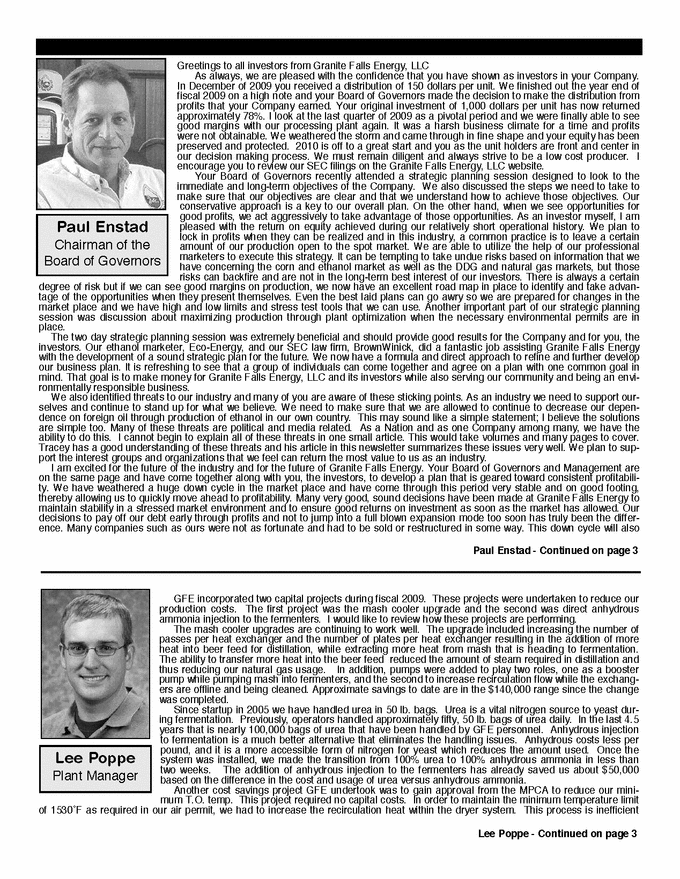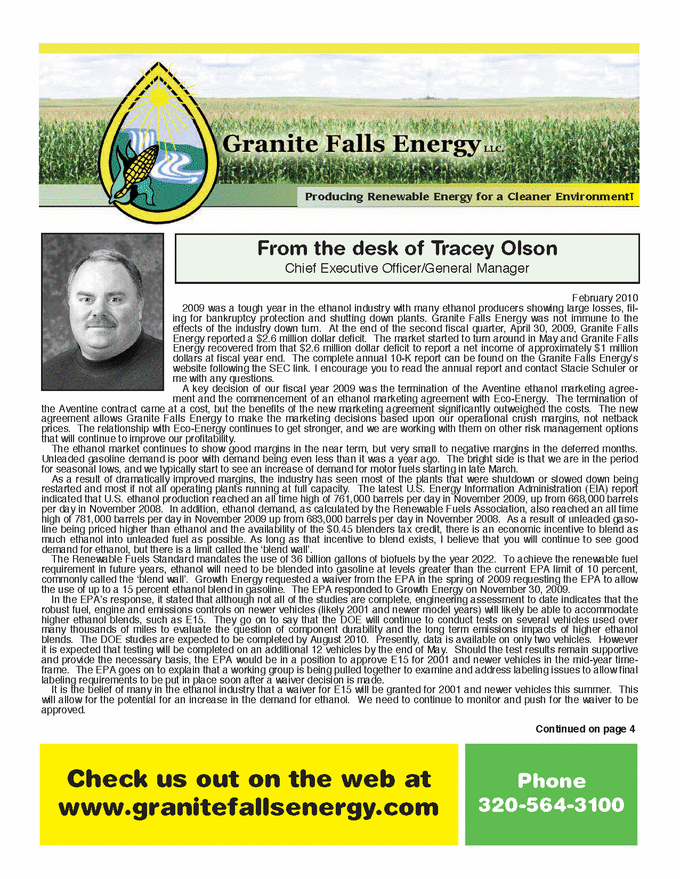
| Paul Enstad Chairman of the Board of Governors Greetings to all investors from Granite Falls Energy, LLC As always, we are pleased with the confidence that you have shown as investors in your Company. In December of 2009 you received a distribution of 150 dollars per unit. We finished out the year end of fiscal 2009 on a high note and your Board of Governors made the decision to make the distribution from profits that your Company earned. Your original investment of 1,000 dollars per unit has now returned approximately 78%. I look at the last quarter of 2009 as a pivotal period and we were finally able to see good margins with our processing plant again. It was a harsh business climate for a time and profits were not obtainable. We weathered the storm and came through in fine shape and your equity has been preserved and protected. 2010 is off to a great start and you as the unit holders are front and center in our decision making process. We must remain diligent and always strive to be a low cost producer. I encourage you to review our SEC filings on the Granite Falls Energy, LLC website. Your Board of Governors recently attended a strategic planning session designed to look to the immediate and long-term objectives of the Company. We also discussed the steps we need to take to make sure that our objectives are clear and that we understand how to achieve those objectives. Our conservative approach is a key to our overall plan. On the other hand, when we see opportunities for good profits, we act aggressively to take advantage of those opportunities. As an investor myself, I am pleased with the return on equity achieved during our relatively short operational history. We plan to lock in profits when they can be realized and in this industry, a common practice is to leave a certain amount of our production open to the spot market. We are able to utilize the help of our professional marketers to execute this strategy. It can be tempting to take undue risks based on information that we have concerning the corn and ethanol market as well as the DDG and natural gas markets, but those risks can backfire and are not in the long-term best interest of our investors. There is always a certain degree of risk but if we can see good margins on production, we now have an excellent road map in place to identify and take advantage of the opportunities when they present themselves. Even the best laid plans can go awry so we are prepared for changes in the market place and we have high and low limits and stress test tools that we can use. Another important part of our strategic planning session was discussion about maximizing production through plant optimization when the necessary environmental permits are in place. The two day strategic planning session was extremely beneficial and should provide good results for the Company and for you, the investors. Our ethanol marketer, Eco-Energy, and our SEC law firm, BrownWinick, did a fantastic job assisting Granite Falls Energy with the development of a sound strategic plan for the future. We now have a formula and direct approach to refine and further develop our business plan. It is refreshing to see that a group of individuals can come together and agree on a plan with one common goal in mind. That goal is to make money for Granite Falls Energy, LLC and its investors while also serving our community and being an environmentally responsible business. We also identified threats to our industry and many of you are aware of these sticking points. As an industry we need to support ourselves and continue to stand up for what we believe. We need to make sure that we are allowed to continue to decrease our dependence on foreign oil through production of ethanol in our own country. This may sound like a simple statement; I believe the solutions are simple too. Many of these threats are political and media related. As a Nation and as one Company among many, we have the ability to do this. I cannot begin to explain all of these threats in one small article. This would take volumes and many pages to cover. Tracey has a good understanding of these threats and his article in this newsletter summarizes these issues very well. We plan to support the interest groups and organizations that we feel can return the most value to us as an industry. I am excited for the future of the industry and for the future of Granite Falls Energy. Your Board of Governors and Management are on the same page and have come together along with you, the investors, to develop a plan that is geared toward consistent profitability. We have weathered a huge down cycle in the market place and have come through this period very stable and on good footing, thereby allowing us to quickly move ahead to profitability. Many very good, sound decisions have been made at Granite Falls Energy to maintain stability in a stressed market environment and to ensure good returns on investment as soon as the market has allowed. Our decisions to pay off our debt early through profits and not to jump into a full blown expansion mode too soon has truly been the difference. Many companies such as ours were not as fortunate and had to be sold or restructured in some way. This down cycle will also Paul Enstad - Continued on page 3 Lee Poppe Plant Manager GFE incorporated two capital projects during fiscal 2009. These projects were undertaken to reduce our production costs. The first project was the mash cooler upgrade and the second was direct anhydrous ammonia injection to the fermenters. I would like to review how these projects are performing. The mash cooler upgrades are continuing to work well. The upgrade included increasing the number of passes per heat exchanger and the number of plates per heat exchanger resulting in the addition of more heat into beer feed for distillation, while extracting more heat from mash that is heading to fermentation. The ability to transfer more heat into the beer feed reduced the amount of steam required in distillation and thus reducing our natural gas usage. In addition, pumps were added to play two roles, one as a booster pump while pumping mash into fermenters, and the second to increase recirculation flow while the exchangers are offline and being cleaned. Approximate savings to date are in the $140,000 range since the change was completed. Since startup in 2005 we have handled urea in 50 lb. bags. Urea is a vital nitrogen source to yeast during fermentation. Previously, operators handled approximately fifty, 50 lb. bags of urea daily. In the last 4.5 years that is nearly 100,000 bags of urea that have been handled by GFE personnel. Anhydrous injection to fermentation is a much better alternative that eliminates the handling issues. Anhydrous costs less per pound, and it is a more accessible form of nitrogen for yeast which reduces the amount used. Once the system was installed, we made the transition from 100% urea to 100% anhydrous ammonia in less than two weeks. The addition of anhydrous injection to the fermenters has already saved us about $50,000 based on the difference in the cost and usage of urea versus anhydrous ammonia. Another cost savings project GFE undertook was to gain approval from the MPCA to reduce our minimum T.O. temp. This project required no capital costs. In order to maintain the minimum temperature limit of 1530°F as required in our air permit, we had to increase the recirculation heat within the dryer system. This process is inefficient Lee Poppe - Continued on page 3 |



